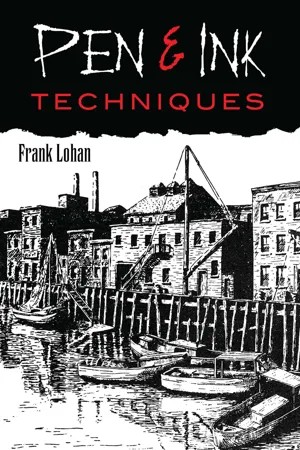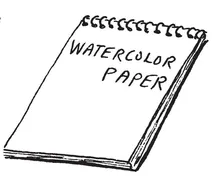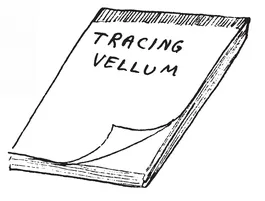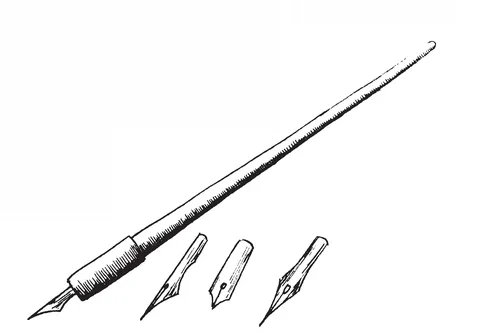![]()
Part I: Basics
Some knowledge of the tools and materials used in pen and ink work is essential. Frequently at the start of a session of my classes some students show up all set to work in ink, but they have a commercial pad of paper that was made for charcoal sketching. Or, worse yet, they have a pad of newsprint. These papers were manufactured for other purposes than ink. They therefore create some problems the beginner can well do without.
This section starts with a discussion of some of the kinds of paper that are suitable for pen and ink work. The usual smooth, hard-surfaced bristol board remains perhaps the most widely used paper for this kind of work. It is not, however, the only paper quite suited for ink. A rough watercolor paper, with the broken-line effect that it frequently causes, can bring an interesting softness to an ink sketch. Read the suggestions, but also experiment for yourself.
Pens, as noted in this section, come in many styles. The simplest is the nib pen; the most expensive are the technical pens. Most artist supply stores carry several makes of each kind of pen and will gladly show you the features offered by each make. How much you spend for a pen will be determined by how serious you are about sketching. If you really intend to get into it, then the more expensive artist’s fountain pen with a couple of points will last a lifetime——and will free you from carrying around ink bottles.
The easiest way to copy, enlarge, or reduce a sketch or a picture that you want to sketch is with the grid system shown in this section. For those whose drawing skills are not well-developed, this scheme is essential to avoid gross errors in perspective. If you do not want to put lines directly on the subject picture, you can create a grid on tracing paper and lay it over your subject Then put the working grid on your sketch paper, and you are ready to go.
It is recommended that you take to heart the comments about minimizing outlines. This will be the biggest single step you can initially take to make your sketches look really professional and to get away from that coloring-book appearance in your work.
![]()
Paper
Paper is no problem for pen and ink work. For practice, almost any good typing paper will do. For final sketches, however, a heavier paper is better.
One of the best papers is bristol board. This comes in several weights—two-ply, three-ply, and up. It is a hard-surfaced paper and takes ink very well. It comes in pads of various sizes—9 x 12, 11 x 14, and so on.
Watercolor paper is also interesting because of its texture. This texture can lend real interest to a pen sketch. Some watercolor papers such as Morilla board come in an off-white or beige color that looks quite good with a dark brown ink.
Watercolor papers come in different weights—80 pound, 140 pound, etc. They are available in pads of various sizes, also.
Sketches can also be done on clear acetate film. Make your pencil composition and lay a piece of acetate over it. Use drawing ink that says “for film” on the box for best results.
You can make a simple watercolor underlay for an acetate sketch. The sketch has all the detail line work, and the simple swatches of color under it can give you a really bright, snappy result. The color should be on a separate sheet of paper under the acetate film.
Tracing vellum is useful to place over your sketch to try different ways of creating a difficult texture. You can try several ways of doing it before you commit yourself to putting ink on your final drawing.
Vellum looks white but is nearly transparent when placed over a pencil drawing. You can also make a watercolor underlay for a vellum sketch, just as with the acetate film, for a different effect.
Any surface that takes ink well can be used for sketching. Colored papers or mat board also give interesting effects.
Scratchboard, a special paper, is discussed and demonstrated later in this book.
![]()
Pens
There are several types of pens for sketching. At the right the standard nib pen is shown. This is the least expensive, the holder costing about 25 cents and each point about 20 cents. There are many different points available in varying degrees of flexibility.
The best to start with is the Crowquill point.
The nib-type pen can be used with any kind of india ink, but it must be kept clean by frequent wiping while you are using it.
The technical pen, often called the Rapidograph type, is shown at the right. This is a tubular point pen; it has no flexibility, and each point makes just one line width. The 000 or 3×0 is good to start with.
The big advantage of this type is that it is a fountain pen and eliminates both carrying ink and constant dipping.
Many different points are available for different line widths.
NEVER use ordinary india ink in these pens. Special ink is required.
There are several makes of technical pen...





